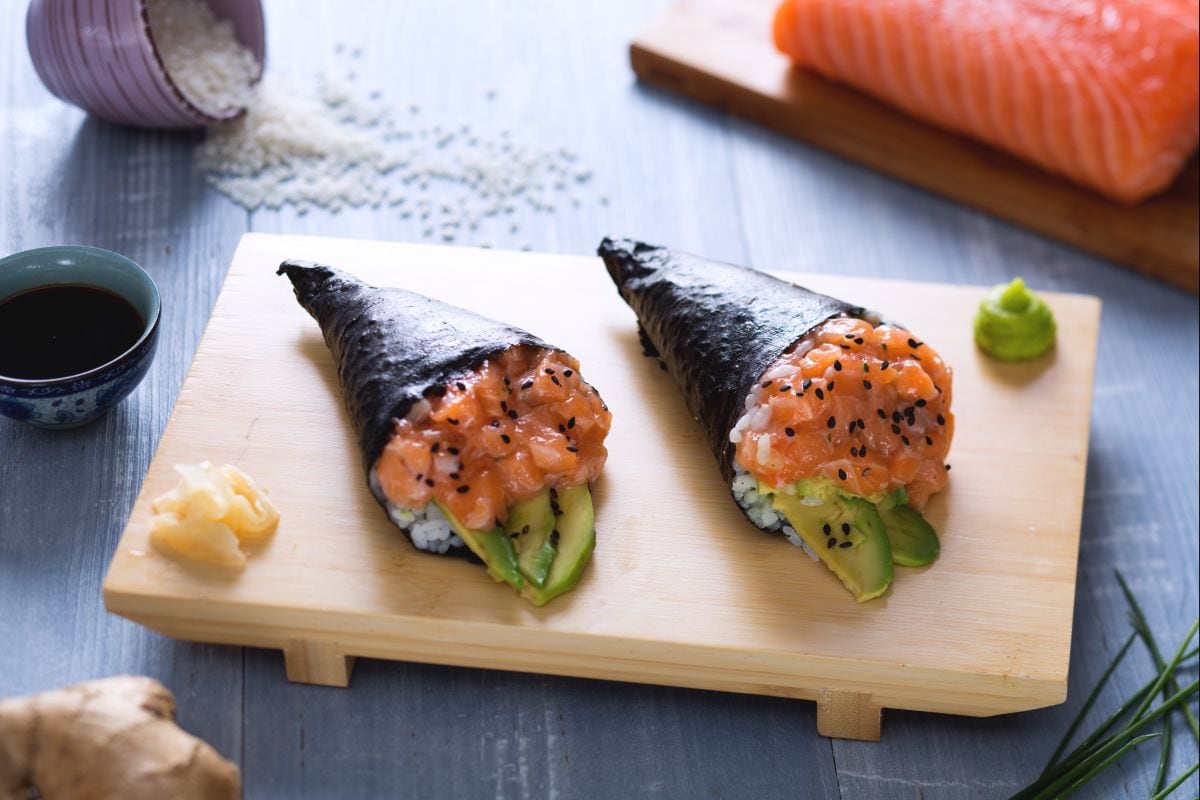Salmon tartare with avocado and toasted almonds
- Average
- 15 min

Salmon temaki is, you know, all about fun and relaxed sushi eating. In Japan, this style of hand roll sushi is a hit at casual hangouts because it is super easy to make and share. So here's the thing: just take a sheet of nori seaweed, shape it into a cone—really simple—and add a layer of sticky, tender sushi rice. Next, pile in thick cubes of sushi-grade salmon, some creamy avocado, and a sprinkle of sesame seeds. Honestly, these little additions give a nutty crunch alongside the moist rice. A swipe of wasabi and a slice of pickled ginger on the side, and it kinda feels like a Friday night in Tokyo.
These sushi hand rolls are just perfect for anyone who loves to get creative. They’re often called the DIY of sushi because everyone can customize their cone with favorite extras. Some might go for a spicy salmon hand roll by mixing in a little sriracha or spicy mayo. Others keep it classic, letting the fresh salmon really, really shine. When you make a batch for friends, it becomes an interactive happy hour—no question. No need for fancy rolling mats—just hands, fresh fish, and lots of laughter. The crispy nori, the soft rice, and that cool, silky salmon deliver the best textures.
And look, following the temaki sushi recipe lets you play with real Japanese techniques, like perfecting the rice and mastering quick cone folds. For real, it's no wonder homemade sushi rolls like these are a go-to for easy parties. People really love the mix of bright flavors, hands-on fun, and food that feels a bit elegant but totally chill at the same time. Whether you're hosting a casual get-together or just enjoying a quiet night in, salmon temaki brings a taste of Japan right to your table, making every meal feel special and social.

To make salmon temaki, you first need to prepare the rice, using round, small-grain sushi rice. Rinse the rice under cold running water 1, at least 5-6 times, stirring with your hands: the water should become clear. Then let it soak for at least 15 minutes. Afterward, drain 2 and let it rest for another 15 minutes. Then pour the rice into a large pot that's not too wide and cover it with water 3.

You can flavor with a piece of kombu seaweed if you prefer, then cover with a lid 4 and bring to a boil over medium heat, never uncovering the pot. Meanwhile, prepare the dressing: pour rice vinegar into a small saucepan and add sugar and salt 5. Turn on low heat and warm it to dissolve the sugar without bringing it to a boil. Once heated and both salt and sugar are dissolved, turn off the heat and let it cool. In the meantime, prepare the hangiri, the specific wooden container where the rice will rest (alternatively, you can use a shallow, wide non-metal container): rinse it with cold water and dry it well with a clean cloth. As soon as the rice water boils, let it boil for 5 minutes, then remove the seaweed with tongs 6, cover again with the lid, lower the heat, and cook for another 8-10 minutes. Turn off the heat and let it rest with the lid on for about 10 minutes.

Then transfer the rice into the wooden container 7, then drizzle with the vinegar-based dressing, letting it trickle with a flat, rounded spatula to distribute it evenly 8. Stir the rice with the spatula, fanning it with a plastic plate to cool it and evaporate the vinegar 9. Once cooled to room temperature

cover it with a clean damp cloth with cold water 10 and let it rest until ready to use. Then take the Norwegian salmon. If using Norwegian salmon, there is no need to treat it before consuming; otherwise, ensure you buy a pre-frozen fillet, or for safety, you can freeze it for a week in the home freezer before eating raw. Remove any bones with kitchen tweezers 11 and remove the skin if present with a sharp knife. Then cut the salmon into strips 12.

then into cubes 13; then mince the chives 14 and set them aside; peel and grate the fresh ginger 15.

In a small bowl, add the salmon, chives 16, and squeeze the juice from the grated ginger pulp using two teaspoons (17-18). Season with salt and pepper, stir, and let the salmon marinate for a few minutes.

Meanwhile, clean the avocado: cut it in half, remove the pit and peel it 19; then slice the flesh 20. Cut a sheet of nori seaweed in half 21

and place some rice, a couple of avocado slices 22, and the seasoned salmon cubes on one half of the sheet 23. Now proceed to roll up to create your salmon temaki: fold the bottom left corner towards the top right part of the nori seaweed to cover the filling 24.

Roll until the end of the nori, creating a cone so that the filling is visible 25; you can help yourself with a bowl of cold water to moisten your hands and work the seaweed cone better. Seal the final corner of the nori seaweed on the cone's end, moistening further to seal it (26-27).

Enrich the cones with black and white sesame seeds (28-29); then serve your salmon temaki with wasabi and pickled ginger petals 30!